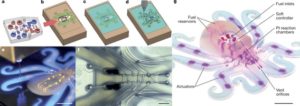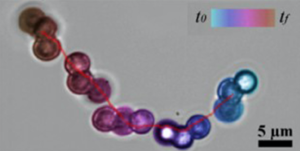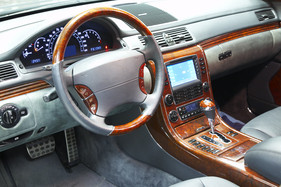We’re seeing a whole lot of chatter over social media, and in the scientific literature on robotics. Our world is set to change over the next five to ten years thanks to autonomous vehicles, Artificial Intelligence, and advanced robotics. We also take a look at some “extreme” robots – those that might not fit into what many would consider a robot… And, we report on the world’s lamest robot too…
But what about soft & squishy robots?
 When we think of robots, we typically think of them built from hard materials, such as plastics or metal — however, Harvard University recently announced a small robotic octopus, which is entirely soft, self powered, and untethered. Chemically powered by hydrogen peroxide, the eight squishy legs are moved in sets of four at a time using microfluidic controllers within the device. (C&EN 9/5/2016, New Scientist 9/3/2016) This is claimed to be the first robot made entirely of non-rigid materials as reported by the journal Nature.
When we think of robots, we typically think of them built from hard materials, such as plastics or metal — however, Harvard University recently announced a small robotic octopus, which is entirely soft, self powered, and untethered. Chemically powered by hydrogen peroxide, the eight squishy legs are moved in sets of four at a time using microfluidic controllers within the device. (C&EN 9/5/2016, New Scientist 9/3/2016) This is claimed to be the first robot made entirely of non-rigid materials as reported by the journal Nature.
Molecular / Microscopic Robots – controlled by human thoughts.
Macromolecule-sized robots are being developed at two Israeli universities, reported in New Scientist which have the ability to deliver psychoactive drugs to specific neurons in response to neuron activity. Evidently, the body of the tiny robot comprises a cage formed from DNA with a gated entrance. A pharmaceutical molecule is trapped within the cage by a gate, “locked” with an iron oxide nanoparticle. The nanoparticle responds to electromagnetic energy by opening the gate and releasing the drug. Such nanobots have the potential to release needed medication at the very onset of, for example, a schizophrenic aggression attach or even a seizure. The bots have been tested on a cockroach, placed inside a coil to induce electromagnetic energy, and controlled by a human wearing ECG electrodes. When the human does mental arithmetic, the drug is released into the cockroach’s brain.
Other nanotechnology medical robots in development include:
 Drexel University who are developing microscale swimmer robots. Small beads form chains that can be controlled by magnetic fields, powering them to swim through the body. The nanobots may be coupled to form chains, or decoupled using the oscillating magnetic field. (Video.) The vision is that these robots may eventually be used to perform surgery and deliver medicine in targeted parts of the body in the future.
Drexel University who are developing microscale swimmer robots. Small beads form chains that can be controlled by magnetic fields, powering them to swim through the body. The nanobots may be coupled to form chains, or decoupled using the oscillating magnetic field. (Video.) The vision is that these robots may eventually be used to perform surgery and deliver medicine in targeted parts of the body in the future.
And, at the Technical University of Athens, Greece, researchers have developed algorithms that describe the coordinated swarming behavior of bats, that use acoustic signals to coordinate, navigate, and hunt their prey. The ingenious leap is to use these algorithms to coordinate nanobots within the body to search for cancerous tumors. The researchers calculate that a small brain tumor may be located by only four bots within a few minutes. It is proposed that the bots would be controlled and monitored using a cap (New Scientist 9/10/16.)
 And, speaking of swimming, a microscopic “outboard motor” for sperm cells has been developed by German researchers to help them swim towards an unfertilized egg. This nanotechnology is also powered by a remote magnetic field. As reported by C&EN, the microscopic robots first wrap themselves around the tail of the sperm cells, then help propel slow, lazy sperm cells by augmenting their swimming power.
And, speaking of swimming, a microscopic “outboard motor” for sperm cells has been developed by German researchers to help them swim towards an unfertilized egg. This nanotechnology is also powered by a remote magnetic field. As reported by C&EN, the microscopic robots first wrap themselves around the tail of the sperm cells, then help propel slow, lazy sperm cells by augmenting their swimming power.
Autonomous Vehicles
 Fully autonomous vehicles are now being tested in Milton Keynes UK, the US (California, Arizona, and other states), Gothenburg Sweden and many other places. Indeed, the Kingdom of Dubai recently announced a strategy directed at becoming the smartest city in the world, with 25% of all transportation trips being smart and driverless by 2030. Traditional auto manufactures – along with a handful of startups – are racing to launch their autonomous vehicles, and have partnered with software companies such as Baidu and Alphabet, as well as ride share providers Uber, Lyft. GM acquired Cruise for $500 MM, placing their first 30 robotic vehicles on the roads. They also recently invested another $500MM in Lyft, and stated an objective of autonomous vehicles available for purchase in 2021.
Fully autonomous vehicles are now being tested in Milton Keynes UK, the US (California, Arizona, and other states), Gothenburg Sweden and many other places. Indeed, the Kingdom of Dubai recently announced a strategy directed at becoming the smartest city in the world, with 25% of all transportation trips being smart and driverless by 2030. Traditional auto manufactures – along with a handful of startups – are racing to launch their autonomous vehicles, and have partnered with software companies such as Baidu and Alphabet, as well as ride share providers Uber, Lyft. GM acquired Cruise for $500 MM, placing their first 30 robotic vehicles on the roads. They also recently invested another $500MM in Lyft, and stated an objective of autonomous vehicles available for purchase in 2021.
Artificial Intelligence in large robots:
Artificial Intelligence (AI) is making steady progress toward broad commercial adoption, with autonomous vehicles being developed by Tesla, Alphabet, Otto Trucks (owned by Uber) and others. AI has also been incorporated into drone technology in the DJI Mavic Pro, which can avoid mid-flight obstacles, and can track and follow moving subjects. A more anthropomorphic AI is exemplified by the Japanese robot Softbank Pepper, which understands speech, interprets human body language, makes gestures of it’s own, and is being tested as a customer assistant for use in retail stores. Fetch Robotics’ bots follow warehouse workers around as they pick items from shelves and help them carry inventory, while Aethon Tug does a similar job with samples and medicines in hospitals.
Robots in the Home
 Robots working in the home include Roomba, the cute little autonomous vacuum cleaners from iRobot have continued to advance, from the clunky early models to the latest with dirt-spotting vision. And Moley Robotics is developing a robotic kitchen to be commercially available in 2017. The video is mesmerizing to watch…
Robots working in the home include Roomba, the cute little autonomous vacuum cleaners from iRobot have continued to advance, from the clunky early models to the latest with dirt-spotting vision. And Moley Robotics is developing a robotic kitchen to be commercially available in 2017. The video is mesmerizing to watch…
Lamest Robot Award: Cornell University Psychology Dept.
Finally, we have an award for the most ineffectual robot. This robot was engineered to conduct a twist of a well documented psychology experiment in which people have a demonstrated tendency to behave more honestly if they see an image of a pair of human eyes. Cornell University’s robot has moving eyes, which track people nearby, and was placed to “stand guard” near a table of snack food with a “RESERVED” label on it in a student common room. Unfortunately, the robot’s sole tactical response to a would-be snack absconder was to look at them with it’s moveable eyes. With no alarms, no blocking movements, no speech, and not even a laser to zap sticky student fingers, it’s not really surprising that the presence of the robot did little to deter raids on the finger food…
